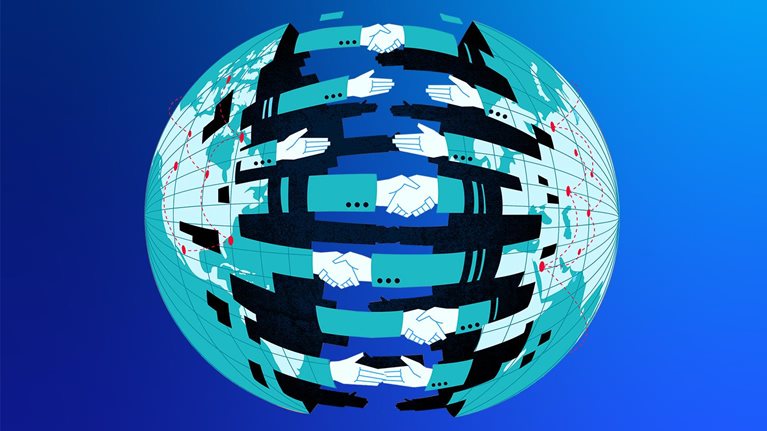The wider the spread between a company’s ROIC and its cost of capital, the more economic profit1 its capital will create. Since global GDP has grown impressively over the past two decades—even given significant geopolitical and market shocks along the way—one might expect that companies’ aggregate economic profit has been rising as well. After all, the high-tech industry has seen the ascendancy of some of the world’s largest corporations, markets within Asia have dramatically expanded, and companies across the globe have been getting better and better at operating their businesses. All the while, global GDP per capita has been increasing.
Yet over the past two decades, companies’ economic profits have, in the aggregate, been shrinking. Their capital has had to work harder just to keep up with historical results. Even so, aggregate levels of economic profit—as with any metric—can also obscure more granular insight. Companies that are headquartered in some regions (in particular, North America) are doing better than others (in particular, those in Europe and the rest of the world). And some industries are doing better too. In this article, we dig into key sectoral, regional, and other differences and explore important implications. Here, too, we find some surprises.
Studying the topic
To gauge economic-profit dynamics, we examined the world’s 4,000 largest public companies, by revenue, in each year, starting in 2005. Because there are important differences between developments prior to the COVID-19 pandemic and those throughout the pandemic, we divided our analysis into a longer 15-year period, ending in 2019. Then we contrasted this time horizon with a two-year period, 2020–21.
This latter view is less definitive than longer time frames because of a shorter averaging period and the unique characteristics of the COVID-19 crisis. Yet those years, particularly when considered together with longer, prior periods, reveal that net economic-profit pools aren’t expanding in lockstep with companies’ revenues or accounting profits.2 Even considering that global economic profit halved from 2005 to 2019 and then rebounded in 2021, global net economic profit is experiencing a notable long-term crunch (Exhibit 1).

Drilling down to details
Three major shifts explain many of the dynamics. First, the cyclical, commodity-driven energy and material sectors endured a pronounced decline in performance. Second, even when excluding energy and materials, economic-profit pools failed to significantly expand, except for companies that are headquartered in North America. Indeed, Europe and the rest of the world, across sectors, lagged behind North America; a typical European-headquartered pharmaceutical company, for example, was likely to underperform its North American peers. Third, smaller “big companies”—those that are large but not large enough to be in the world’s top 500 companies by revenue—have deteriorated severely in their contribution to global economic profit.
The long-term decline of energy and materials
Beware of letting the postpandemic uptick in energy and materials sectors distort a more complete picture. While the 2020–21 recovery was indeed mostly driven by energy and materials, the longer-term historical trend of shrinking global economic-profit pools has been led by a sharp decline in those same sectors, which were weighed down by low commodity prices paired with low investments (Exhibit 2). The remaining industries showed modest economic-profit growth of 26 percent over ten years, or 2.3 percent on an annualized basis, which is slightly above global real GDP growth of 1.8 percent per annum.

At a global level, industries based in technology and intellectual property, such as advanced industries and technology and media, were able to expand their economic-profit pools. The air and travel, consumer goods, and pharmaceutical and medical-product industries contributed a moderate expansion of global economic-profit pools.
Other industries—though not as hard hit as energy and materials—found it harder to grow economic profit. The global telecommunication industry, for one, faced declining economic-profit pools; competitive intensity increased as markets became both more saturated and more prone to tighter regulation. Conglomerates, particularly in Asia, also saw their cumulative economic profit decline significantly.
The gap between North America and the rest of the world
Europe and the rest of the world demonstrably failed to keep up with North American companies in economic profit. To gain further insight, we disaggregated the change in economic profit (excluding energy and materials) into its five drivers: revenue, operating margin, capital turnover, tangible capital ratio, and weighted average cost of capital (WACC) (Exhibit 3).

Comparing 2005–09 and 2015–19 numbers, companies headquartered in North America (excluding those in the energy and materials sectors) rose to a share of 77 percent, from 50 percent, in global economic-profit pools (Exhibit 4). Companies from all other regions, on the other hand, saw their shares of economic profit cut in half. European companies’ shares fell dramatically; the rest of the world went from 17 percent to only 2 percent of economic profit, even though non–North American and non-European companies represent half of the companies in the global 4,000 sample, and even though China has been the world’s renowned growth engine as measured by revenues.

The stunning reduction has been driven largely by local underperformance of conglomerates and travel and logistics companies; the telecommunications industry has faced difficulties in every region. Overall, North America generated more than 3.5 times as much economic profit as Europe in the 2015–19 period and a staggering 30 times as much as the rest of the world.
At first glance, it’s perhaps unsurprising that North America would have surged ahead. The US technology sector is a global dynamo and accounts for a significant part of the difference between North America and all other regions. But technology isn’t the whole story. The technology and media industries accounted for only about 39 percent ($79 billion) of North America’s increase in economic profit. The advanced-industrial ($52 billion), pharmaceutical and medical-technology ($26 billion), air and travel ($22 billion), and consumer ($15 billion) sectors strongly contributed to the uplift. Telecommunications was the only large sector in North America in which economic profit declined (–$5 billion).
In Europe, only one sector was able to grow economic profit considerably: advanced industrials, which added $28 billion. Europe’s sizable consumer sector stagnated, while the economic profit of its technology and media (–$12 billion) and pharmaceutical and medical-technology (–$12 billion) industries declined. The European telecommunications industry took the biggest hit; its economic profit shrank by $35 billion.
Outside Europe and North America, the advanced-industrial sector ($9 billion) was able to expand cumulative economic profit the most, given the strong performance of the automotive and semiconductor industries in Greater China, Japan, and Korea. The rest of the world’s consumer ($6 billion) and technology and media ($6 billion) industries were also able to grow economic profit considerably. At the other end of the spectrum, conglomerates, relatively common in Latin America and parts of Asia, saw economic-profit pools decline sharply (–$49 billion).
We found that companies headquartered in North America were able to grow revenues by an aggregate 3.2 percent per annum in real terms. Even more important, they improved their margin for net operating profit after taxes (NOPAT) to 10.7 percent, from 8.4 percent. This more than compensated for the considerable capital that they spent on M&A, as evidenced by a decline in their tangible capital ratio to 49 percent, from 60 percent. It remains to be seen how long North American companies can maintain their strong margins.
European-headquartered companies trailed other regions considerably in growth and margin improvement. Their average revenue grew at only 0.1 percent per annum, and their average operating margins improved only slightly (to 9.6 percent, from 9.3 percent). In capital efficiency, European companies showed slightly better improvement than North American companies but continued to trail in absolute terms. A leading driver of European economic-profit decline was M&A, which failed to add enough revenue growth and margin expansion to compensate for the hit that deals imposed on balance sheets.
Companies in other regions of the world fared even worse, driven down by poor capital efficiency and an increasing cost of capital (to 7.6 percent, from 6.9 percent). Their decline in economic profit was, again, particularly striking, given that they demonstrated considerable revenue growth (3.2 percent per annum) and margin expansion (6.1 percent, from 5.4 percent, in average NOPAT margin).
The increasing importance of scale
While achieving higher revenue doesn’t necessarily translate to creating more value, there has been an intriguing development from 2015 to 2019: the bulk of economic profit has been concentrated in the top 500 companies by average revenue (Exhibit 5). This concentration has become more pronounced over time, as globalization and digitization have amplified the effects of scale.

The share of the top 500 companies in the total revenue pool has been stable over time, at approximately 60 percent. However, larger companies have been able to translate economies of scale into higher ROIC, which helps explain the disproportionate increase in their share of total economic profit. When we decomposed companies by revenue size, we found that from 2005 to 2009, the average ROIC–WACC spread was 8 percent for the ten largest companies, 4 percent for the next 90 largest companies, and slightly less than 3 percent for the next 400 companies. The smallest 3,500 companies by revenue size, on the other hand, had a spread that barely exceeded 1 percent.
Over the following decade, ROIC–WACC spreads deteriorated across all groups of companies but squeezed the smallest 3,500 companies the hardest; on average, their spread approached zero. As a result, the share of the smallest 3,500 companies fell to only 3 percent, from 19 percent, of global economic profit.
Emerging implications
The future is always uncertain, and the dramatic shocks during and since the outbreak of the COVID-19 pandemic highlight how sharply scenarios may diverge in the years ahead.3 Yet given the long period studied, the large number of companies examined across geographies, and the current macroeconomic information and developments now available, important implications of the global economic-profit crunch can be drawn:
- A wake-up call for Europe and Asia. While some of the largest companies in the world are headquartered in Europe, they and other European corporations are clearly losing ground to their North American peers. Corporations and regulators alike should pay particular attention to the innovation of North American companies—their “secret sauce.” As our colleagues have detailed in a report on securing Europe’s competitiveness, Europe can create conditions for new, profitable, high-growth segments to flourish.4 Regulators play an important role in making sure that consumers are protected and determining equitable divisions of profits among workers and shareholders. From a growth perspective, effective regulation also strives to ensure that regulated sectors can succeed in the global arena in a sustainable way. Similarly, our colleagues have published a discussion on a practicable path for Asian companies to reallocate capital to higher-return opportunities.5
- Keeping up with big players. While large but not super-large companies are often described as the backbone of the global economy, their share of global economic profit is weakening. Of the 4,000 largest companies studied, those ranking outside the top 500 generated $8.3 billion in economic profit—which comes to less than $2.4 million per company. It’s becoming increasingly imperative for these companies to scale up or find new opportunities with the potential for value creation. They can also capture opportunities by adopting professional-management best practices, investing in digital and analytics, and attracting and retaining talent. The Titanium Economy: How Industrial Technology Can Create a Better, Faster, Stronger America (PublicAffairs, 2022) describes small and midsize companies that raised their game significantly in such areas.6
- Practicing judicious M&A. The underperformance of smaller companies may turn them into targets for larger companies in a new wave of M&A. But while current conditions hold promise for acquirers, capturing the opportunities may become harder. For instance, regulators in Europe and the United States are approaching larger deals with increasing scrutiny. Additionally, goodwill incurred from M&A transactions alone has, on aggregate, wiped out progress made in operating-margin improvements outside North America. Europe, across sectors, and the global consumer industry have seen value destruction during recent M&A waves. Value-creating deals are more likely when companies follow a programmatic M&A approach, which has been shown to boost the odds of achieving market-beating returns and growth rates compared with other deal-making approaches. The relatively weak economic-profit performance of the “next 3,500 companies” might also provide compelling M&A opportunities for the top 500.
- Energy playing offense. Massive investments are needed to make the net-zero transition a reality and to increase the resilience of the global energy system. The strong decline in economic profit that energy and materials companies experienced in 2015–19, compared with the prior decade, has become increasingly evident. It has contributed to a decline in global energy investment since 2014 (despite a modest increase in nonfossil-energy investments during the same period). But leading energy companies are learning to play offense as they address the consequences of climate change and capture new opportunities from the transition. In 2020–21, the performance of the energy and materials sectors improved. Meeting the world’s energy needs while focusing relentlessly on the long term can help ensure that increased profitability translates to sustainable value creation.
Global economic profit has been under a significant crunch, and capital has needed to work harder. Yet the developments that have had the most impact lie beneath the headlines. It’s essential to disaggregate global aggregates and explore differences across regions, sectors, and company sizes to gain a more actionable perspective. These analyses enable companies, stakeholders, and regulators not only to recognize what has changed but also to understand how capital can unleash more value-creating opportunities now and in the decades ahead.


